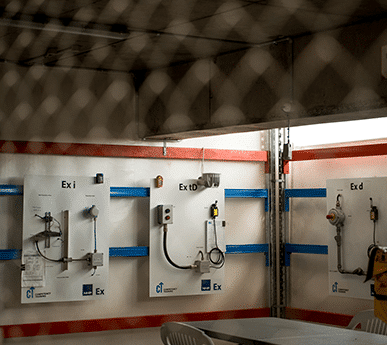Not known Factual Statements About Roar Solutions
Not known Factual Statements About Roar Solutions
Blog Article
Not known Facts About Roar Solutions
Table of ContentsThings about Roar SolutionsRumored Buzz on Roar SolutionsRoar Solutions Things To Know Before You Buy
In such an environment a fire or explosion is feasible when three standard problems are met. This is typically referred to as the "unsafe area" or "burning" triangle. In order to protect installations from a potential surge a technique of evaluating and classifying a possibly unsafe location is called for. The purpose of this is to guarantee the correct option and setup of equipment to eventually stop an explosion and to guarantee safety of life.
(https://www.40billion.com/profile/91601565)
No devices must be mounted where the surface temperature level of the tools is higher than the ignition temperature of the given danger. Below are some typical dirt unsafe and their minimum ignition temperature. Coal Dirt 380C 225C Polythene 420C (melts) Methyl Cellulose 420C 320C Starch 460C 435C Flour 490C 340C Sugar 490C 460C Grain Dust 510C 300C Phenolic Material 530C > 450C Aluminium 590C > 450C PVC 700C > 450C Soot 810C 570C The probability of the hazard being present in a focus high enough to create an ignition will vary from location to area.
In order to identify this danger an installation is divided right into areas of risk depending upon the amount of time the dangerous is existing. These areas are described as Areas. For gases and vapours and dirts and fibres there are three zones. Area 0 Area 20 An unsafe environment is very most likely to be existing and may exist for long periods of time (> 1000 hours per year) and even continually Area 1 Zone 21 An unsafe environment is feasible yet not likely to be present for long durations of time (> 10 450 C [842 F] A classification of T6 indicates the minimal ignition temperature level is > 85 C [185 F] Harmful area electrical equipment possibly made for use in greater ambient temperature levels. This would showed on the rating plate e.g. EExe II C T3 Ta + 60C( This suggests at 60C ambient T3 will certainly not be gone beyond) T1 T1, T2, T3, T4, T5, T6 T2 T2, T3, T4, T5, T6 T3 T3, T4, T5, T6 T4 T4, T5, T6 T5 T5, T6 T6 T6 A T Course score of T1 means the maximum surface area temperature level generated by the tool at 40 C is 450 C. Presuming the connected T Class and Temperature level ranking for the tools are ideal for the area, you can constantly make use of a tool with an extra rigid Division score than needed for the location. There isn't a clear answer to this concern. It really does depend upon the sort of tools and what fixings need to be performed. Equipment with specific examination treatments that can not be carried out in the field in order to achieve/maintain third party rating. Need to come back to the factory if it is prior to the equipment's service. Area Repair Service By Authorised Personnel: Challenging testing might not be needed nevertheless certain treatments might need to be complied with in order for the devices to preserve its third party rating. Authorised personnel should be utilized to do the work correctly Fixing must be a like for like substitute. New element have to be considered as a direct replacement requiring no unique screening of the devices after the repair service is full. Each piece of devices with a harmful ranking should be assessed individually. These are detailed at a high level below, however for even more in-depth details, please refer directly to the guidelines.
Examine This Report on Roar Solutions
The devices register is a comprehensive database of devices documents that includes a minimum set of fields to recognize each item's location, technological specifications, Ex category, age, and environmental data. This information is essential for monitoring and taking care of the devices properly within dangerous locations. In comparison, for regular or RBI tasting assessments, the grade will certainly be a mix of Comprehensive and Close examinations. The ratio of Thorough to Close assessments will be established by the Equipment Danger, which is assessed based on ignition danger (the chance of a resource of ignition versus the probability of a flammable ambience )and the hazardous location category
( Area 0, 1, or 2). This variation will certainly also influence the resourcing requirements for job prep work. Once Whole lots are defined, you can establish tasting plans based upon the sample size of each Lot, which refers to the variety of arbitrary devices things to be examined. To establish the required sample size, 2 aspects need to be assessed: the size of the Great deal and the classification of inspection, which suggests the degree of initiative that must be applied( lowered, regular, or raised )to the examination of the Lot. By combining the category of inspection with the Whole lot size, you can after that establish the proper rejection criteria for an example, implying the permitted variety of defective items found within that example. For even more details on this procedure, please refer to the Energy Institute Standards. The IEC 60079 conventional recommends that the optimum interval between inspections ought to not exceed three years. EEHA examinations will additionally be performed beyond RBI campaigns as part of scheduled upkeep and tools overhauls or fixings. These examinations can be credited toward the RBI sample dimensions within the affected Whole lots. EEHA assessments are conducted to recognize faults in electrical equipment. A weighted scoring system is necessary, as a solitary item of tools might have multiple faults, each with varying levels of ignition danger. If the mixed rating of both assessments is less than twice the mistake score, the Whole lot is considered appropriate. If the Great deal is still considered unacceptable, it has to go through a full evaluation or justification, which may activate more stringent examination methods. Accepted Great deal: The root causes of any type of mistakes are determined. If a typical failure mode is found, extra equipment might require inspection and fixing. Mistakes are classified by seriousness( Safety, Integrity, House cleaning ), making sure that immediate issues are evaluated and attended to without delay to reduce any kind of impact on safety or procedures. The EEHA data source should track and tape the lifecycle of mistakes along with the rehabilitative actions taken. Implementing a robust Risk-Based Examination( RBI )technique is essential for ensuring compliance and safety in handling Electrical Devices in Hazardous Locations( EEHA) (Roar Training Solutions). Automated Fault Rating and Lifecycle Administration: Easily take care of faults and track their lifecycle to enhance inspection precision. The introduction of this support for risk-based inspection better reinforces Inspectivity's placement as a best-in-class option for governing compliance, as well as for any asset-centric examination usage situation. If you are interested in finding out more, we welcome you to request a presentation and discover just how our service can transform your EEHA management procedures.
The Best Guide To Roar Solutions

In regards to eruptive get redirected here risk, an unsafe location is an environment in which an explosive environment is present (or might be expected to be existing) in quantities that need special preventative measures for the building and construction, installment and use equipment. hazardous area electrical course. In this article we check out the obstacles dealt with in the workplace, the danger control measures, and the needed expertises to work safely
These compounds can, in particular conditions, develop explosive atmospheres and these can have major and heartbreaking consequences. Most of us are acquainted with the fire triangular remove any type of one of the three elements and the fire can not happen, but what does this mean in the context of dangerous locations?
In the majority of instances, we can do little concerning the degrees of oxygen airborne, yet we can have considerable impact on resources of ignition, for example electrical devices. Harmful locations are documented on the hazardous area classification illustration and are recognized on-site by the triangular "EX-SPOUSE" indicator. Below, among various other crucial details, zones are divided right into three types depending on the risk, the likelihood and duration that an explosive environment will exist; Area 0 or 20 is regarded the most hazardous and Area 2 or 22 is deemed the least.
Report this page